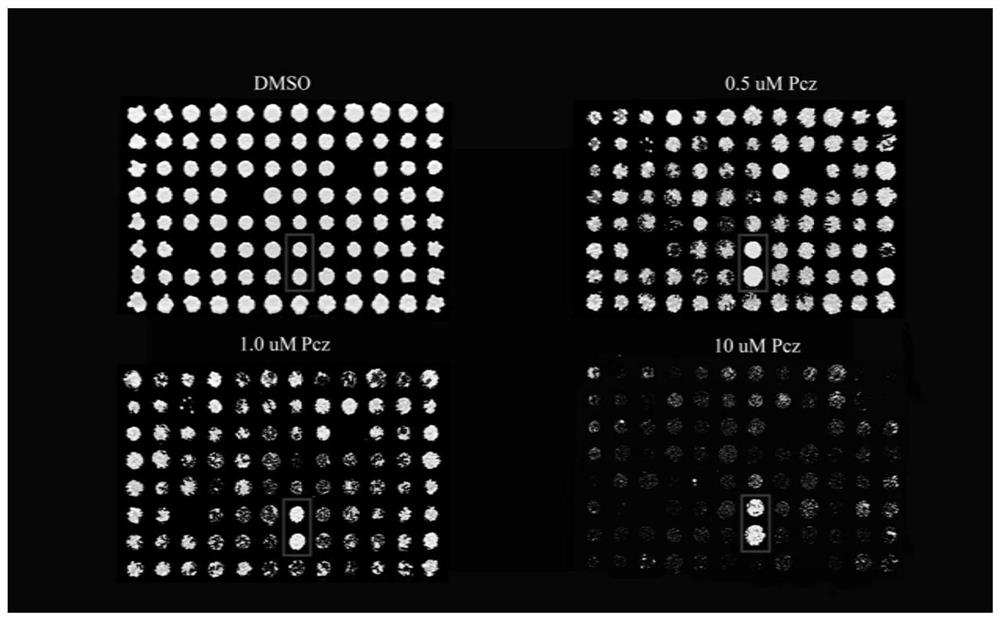Application of brassica rapa brassica BraALA3 and BraENT1 gene families in regulation and control of absorption and accumulation of propiconazole
A technology of propiconazole and cabbage, which is applied in the field of plant genetic engineering, can solve the problems of pesticide residues, shorten the breeding years, hidden dangers and the like, and achieve the effects of increased sensitivity and great application prospects.
- Summary
- Abstract
- Description
- Claims
- Application Information
AI Technical Summary
Problems solved by technology
Method used
Image
Examples
Embodiment 1
[0040] Example 1 Yeast-deficient library screening of propiconazole-related transport genes
[0041] 1. Activation of yeast-deficient library
[0042] Transfer the yeast-deficient library from -80°C ultra-low temperature freezer to 4°C freezer to thaw. Use a 96-pin replicator to transfer the mutant strains from a standard 96-deep well plate to a YPD solid plate for activation, and culture at 30°C for 2 days until a large colony is formed.
[0043] 2. Propiconazole screening of yeast-deficient library
[0044] Use a 96-pin replicator to inoculate the mutant strain on the activated plate in a standard 96 deep-well plate containing 200 μL of liquid YPD, shake it in a shaker at 180 rpm at 30°C for 12 hours, and then transfer 25 μL of the bacterial solution to the 96-well plate containing 1 mL of liquid YPD. Continue to activate for 3h in the deep well plate. Pipette 25 μL of the reactivated bacterial solution into a 96-deep well plate containing 1 mL of sterile water. Pipette ...
Embodiment 2
[0050] Example 2 Introducing BraALA3 and BraENT1 Deficient Yeast Sensitivity Experiment to Propiconazole
[0051] 1. Cloning of Chinese cabbage BraALA3 and BraENT1
[0052] 1) Total RNA extraction and cDNA synthesis
[0053] Oil green 701 Chinese cabbage was sown in a seedling tray, and cultured for 4 weeks at 20°C under the conditions of 12 hours of light and 12 hours of darkness. Kit (OMEGA) was used to extract RNA, and reverse transcription was performed according to PrimeScript Reverse Transcription Kit (TaKaRa Biological Co., Ltd., Dalian, China).
[0054] 2) Construct TA vector
[0055] The extracted cDNA was used as a template, and the upstream and downstream homology arm sequences of the BraALA3 gene were amplified by PCR. The cDNA amplification concentration was 5 ng / μL, and the following reaction mixture was used: 5 μL 5×GC buffer; 2 μL dNTPs; 10 μM each primer 1.25 μL; 0.75 μL DMSO; 0.25 μL pusion DNA polymerase; 1 μL gDNA (5ng); 2 0 to 20 μL.
[0056] Wherein,...
Embodiment 3
[0131] Example 3 The W303 strain yeast introduced with BraALA3 and BraENT1 is sensitive to propiconazole
[0132] 1. Yeast overexpression strain construction
[0133] 1) Restriction digestion of pYES2 vector
[0134] Set up the enzyme digestion reaction system: 3 μL BamHI (Takara); 3 μL EcoRI (Takara); 10 μL 10×Mbuffer (Takara); 3 ug complete pYES2 plasmid; deionized H2O to a final volume of 100 μL. Digested at 37°C for 3 hours, and purified by gel extraction kit (OMEGA).
[0135] 2) Amplify flanking sequences
[0136] Extract the constructed A-Bra-ALA3-01, TA-Bra-ALA3-03, TA-Bra-ALA3-09, and TA-BraENT1 as templates, and perform PCR amplification on the BraALA3 and BraENT1 genes. The concentration of the plasmid amplification is 5 ng / μL, use the following reaction mixture: 5 μL 5×GC buffer; 2 μL dNTPs; 1.25 μL each primer at 10 μM; 0.75 μL DMSO; 0.25 μL pusion DNA polymerase; 1 μL gDNA (5 ng); Wherein the homology arm amplification primer sequences of the three homologous ...
PUM
 Login to View More
Login to View More Abstract
Description
Claims
Application Information
 Login to View More
Login to View More - R&D
- Intellectual Property
- Life Sciences
- Materials
- Tech Scout
- Unparalleled Data Quality
- Higher Quality Content
- 60% Fewer Hallucinations
Browse by: Latest US Patents, China's latest patents, Technical Efficacy Thesaurus, Application Domain, Technology Topic, Popular Technical Reports.
© 2025 PatSnap. All rights reserved.Legal|Privacy policy|Modern Slavery Act Transparency Statement|Sitemap|About US| Contact US: help@patsnap.com



